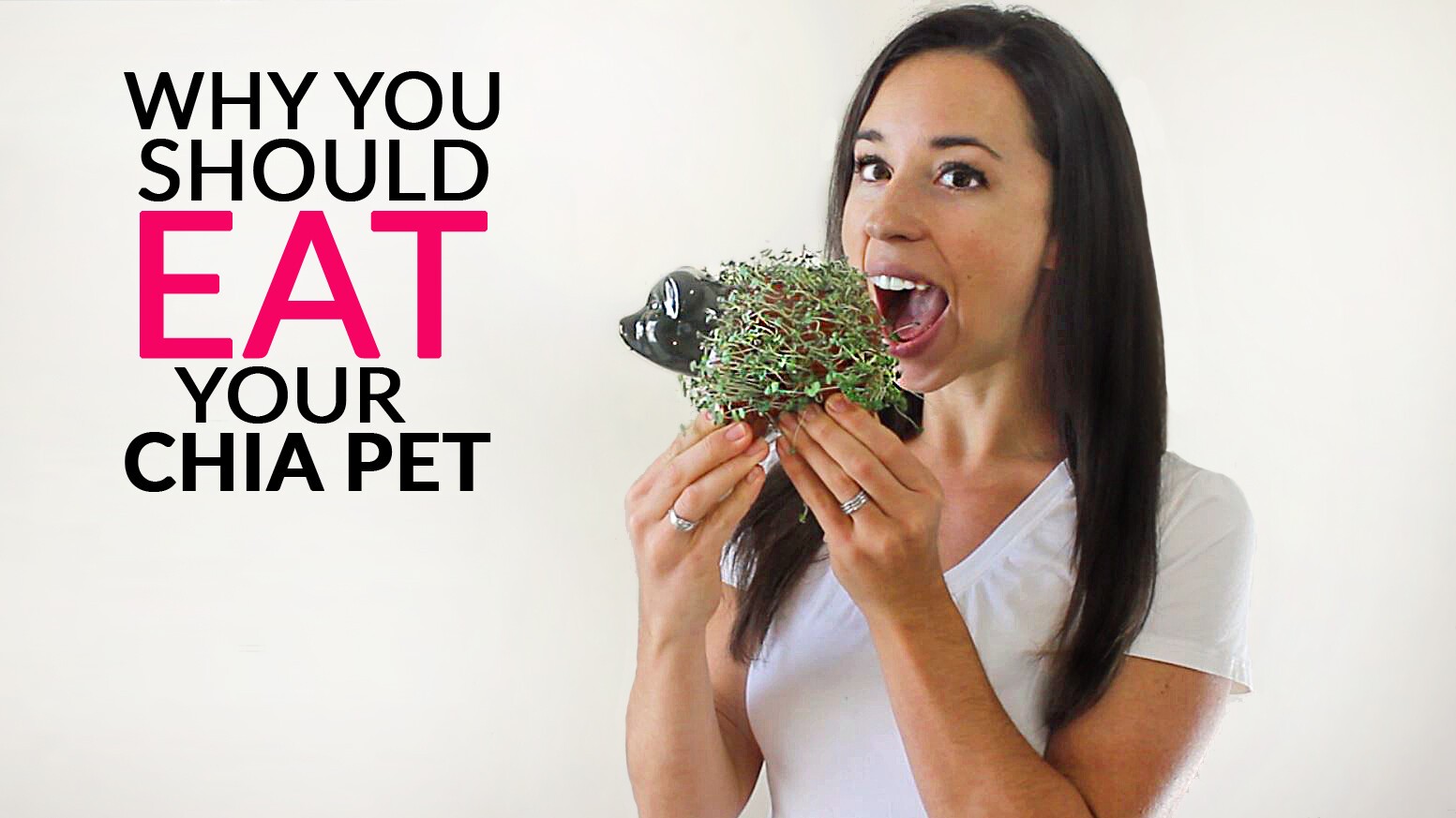Can You Eat Chia Pet Greens? Absolutely! Chia Pet greens are essentially sprouted chia seeds, a nutritional powerhouse packed with health benefits. At PETS.EDU.VN, we delve into the world of edible sprouts, exploring the safety and nutritional advantages of incorporating Chia Pet greens into your diet, offering a simple solution to boost your overall well-being. Discover the nutritional value, health benefits, and culinary uses of sprouted chia seeds.
1. Understanding Chia Pets and Chia Seeds
Chia Pets, the nostalgic pottery planters, have introduced many to the wonders of chia seeds. But are the greens that sprout from these pets safe to eat? Let’s explore the basics.
What is a Chia Pet?
A Chia Pet is a terra cotta figurine designed to be covered with moistened chia seeds. These seeds sprout, creating a green “fur” or “hair” effect. They are a popular novelty item, but their potential as a source of nutritious sprouts is often overlooked.
What are Chia Seeds?
Chia seeds are small, nutrient-dense seeds from the Salvia hispanica plant. They are rich in omega-3 fatty acids, fiber, protein, and various micronutrients. Chia seeds have gained popularity as a superfood due to their numerous health benefits.
 Chia seeds on a spoon
Chia seeds on a spoon
Nutritional Profile of Chia Seeds
Chia seeds offer an impressive nutritional profile. According to studies published in the “Journal of Food Science and Technology,” chia seeds are excellent sources of:
- Omega-3 Fatty Acids: Essential for heart and brain health.
- Fiber: Promotes digestive health and helps regulate blood sugar levels.
- Protein: Important for muscle building and repair.
- Antioxidants: Protect the body against free radicals.
- Minerals: Including calcium, phosphorus, and manganese, crucial for bone health.
2. Are Chia Pet Greens Safe to Eat?
While the idea of eating greens from a Chia Pet might seem novel, it’s crucial to consider safety. Here’s a breakdown of factors to consider:
Source of Chia Seeds
The chia seeds that come with Chia Pets are not intended for consumption. According to Joseph Enterprises VP, the company that makes Chia Pets, these seeds aren’t cleaned to the same standards as those sold for eating and don’t undergo the same FDA compliance processes. It’s safer to use certified organic chia seeds specifically sold for culinary use.
Potential Contamination
Chia Pets can harbor bacteria or mold if not properly cleaned and maintained. The moist environment required for sprouting can be a breeding ground for harmful microorganisms. Always ensure the Chia Pet is thoroughly cleaned before and during the sprouting process.
Recommended Chia Seeds
For safe consumption, it’s best to use high-quality, food-grade chia seeds. Look for certified organic chia seeds from reputable brands. These seeds are tested for purity and safety, reducing the risk of contamination.
Alt Text: Close up of organic chia seeds in a bowl, ready for consumption, sourced by MyDiet.
3. Health Benefits of Eating Chia Pet Greens (Sprouted Chia Seeds)
When sourced safely, sprouted chia seeds offer numerous health benefits.
Enhanced Nutritional Value
Sprouting chia seeds increases their nutritional value. The sprouting process reduces phytates, which can inhibit nutrient absorption. This makes the nutrients in chia seeds more bioavailable.
Improved Digestion
Sprouted seeds are generally easier to digest than unsprouted seeds. The enzymes produced during sprouting help break down complex carbohydrates and proteins, making them more digestible.
Rich in Enzymes
Sprouted chia seeds are rich in enzymes, which aid in digestion and nutrient absorption. Enzymes play a crucial role in breaking down food into smaller, more easily absorbed molecules.
Antioxidant Properties
Sprouted chia seeds contain antioxidants that help protect the body against oxidative stress. Antioxidants neutralize free radicals, reducing the risk of chronic diseases.
Chlorophyll Boost
Chia sprouts, like other greens, contain chlorophyll, a powerful blood cleanser and builder. Chlorophyll replenishes and increases red blood cell count, enhancing oxygen delivery throughout the body.
4. How to Safely Grow and Eat Chia Pet Greens
Growing and eating Chia Pet greens can be a fun and nutritious activity. Here’s a step-by-step guide to ensure safety and maximize benefits:
Step 1: Choose the Right Chia Seeds
Purchase certified organic chia seeds specifically intended for consumption. Avoid using the seeds that come with a Chia Pet, as they are not meant for eating.
Step 2: Clean the Chia Pet
Thoroughly clean the Chia Pet with soap and water. Ensure all traces of soap are rinsed away. Sanitize the Chia Pet with a diluted bleach solution (1 part bleach to 10 parts water) to kill any potential bacteria or mold. Rinse thoroughly.
Step 3: Soak the Chia Seeds
Soak 1-2 tablespoons of chia seeds in a bowl of water for about 15 minutes. This will create a gel-like consistency, making it easier for the seeds to stick to the Chia Pet.
Step 4: Apply Seeds to the Chia Pet
Spread the soaked chia seeds evenly over the surface of the Chia Pet. Ensure the seeds are well-distributed for even sprouting.
Step 5: Water Regularly
Keep the Chia Pet moist by watering it 1-2 times a day. Use a spray bottle to gently mist the seeds. Avoid overwatering, which can lead to mold growth.
Step 6: Harvest the Greens
The chia seeds should sprout within 3-7 days. Once the greens are about 1-2 inches long, they are ready to harvest. Use scissors to trim the greens.
Step 7: Wash the Sprouts
Wash the harvested sprouts thoroughly with water to remove any dirt or debris.
Step 8: Enjoy!
Add the chia sprouts to salads, smoothies, sandwiches, or use them as a garnish.
5. Culinary Uses of Chia Pet Greens
Chia Pet greens (sprouted chia seeds) can be a versatile addition to your diet. Here are some creative ways to incorporate them into your meals:
Salads
Sprinkle chia sprouts over salads for added texture and nutrition. They pair well with leafy greens, vegetables, and dressings.
Smoothies
Blend chia sprouts into smoothies for a boost of omega-3 fatty acids, fiber, and protein. They add a mild, nutty flavor to your favorite smoothie recipes.
Sandwiches and Wraps
Add chia sprouts to sandwiches and wraps for extra crunch and nutrition. They complement a variety of fillings, including vegetables, meats, and cheeses.
Garnish
Use chia sprouts as a garnish for soups, stews, and other dishes. They add a pop of color and a nutritional boost.
Juices
Adding Chia Pet greens to juices is a great way to add a nutritious kick. The mild flavor of the sprouts won’t overpower your favorite juice recipes.
Alt Text: A vibrant salad is elevated with a sprinkle of nutritious chia seeds, as featured on WellPlated.
6. Potential Risks and Precautions
While sprouted chia seeds are generally safe, it’s important to be aware of potential risks and take necessary precautions.
Allergies
Some individuals may be allergic to chia seeds. If you experience symptoms such as itching, hives, swelling, or difficulty breathing after consuming chia seeds, discontinue use and seek medical attention.
Digestive Issues
Consuming large amounts of chia seeds can cause digestive issues such as bloating, gas, and diarrhea, especially if you’re not used to eating high-fiber foods. Start with small amounts and gradually increase your intake to allow your digestive system to adjust.
Phytic Acid
Chia seeds contain phytic acid, which can inhibit the absorption of certain minerals. Sprouting chia seeds helps reduce phytic acid levels, improving nutrient absorption.
Cross-Contamination
Ensure that the Chia Pet and sprouting environment are clean to prevent cross-contamination with harmful bacteria or mold. Regularly clean and sanitize the Chia Pet to maintain a safe growing environment.
7. Chia Seeds vs. Other Sprouts
Chia sprouts are just one type of edible sprout. Here’s a comparison to other popular sprouts:
| Sprout Type | Nutritional Benefits | Culinary Uses |
|---|---|---|
| Chia Sprouts | High in omega-3 fatty acids, fiber, protein, antioxidants, and minerals. | Salads, smoothies, sandwiches, garnishes. |
| Alfalfa Sprouts | Rich in vitamins A, C, E, and K, as well as minerals such as calcium, magnesium, and potassium. | Salads, sandwiches, wraps, stir-fries. |
| Broccoli Sprouts | High in sulforaphane, a potent antioxidant with anti-cancer properties. | Salads, sandwiches, smoothies, soups. |
| Radish Sprouts | Good source of vitamins C and K, as well as antioxidants. They have a peppery flavor. | Salads, sandwiches, garnishes, stir-fries. |
| Mung Bean Sprouts | Low in calories and high in vitamins C and K, as well as fiber and protein. | Stir-fries, salads, spring rolls, soups. |
| Lentil Sprouts | Excellent source of protein, fiber, iron, and folate. | Salads, soups, stews, side dishes. |
| Sunflower Sprouts | Rich in vitamins A, B, D, and E, as well as minerals such as calcium, iron, and zinc. They have a nutty flavor. | Salads, sandwiches, smoothies, snacks. |
| Pea Sprouts | High in vitamins A, C, and K, as well as fiber and protein. They have a sweet, pea-like flavor. | Salads, stir-fries, soups, garnishes. |
Each type of sprout offers unique nutritional benefits and culinary uses. Chia sprouts stand out for their high omega-3 fatty acid content, while broccoli sprouts are known for their sulforaphane content.
8. Expert Opinions on Eating Chia Pet Greens
Experts in nutrition and food safety offer valuable insights on the safety and benefits of eating chia pet greens:
- Nutritionists: Emphasize the importance of using food-grade chia seeds and maintaining a clean growing environment. They highlight the nutritional benefits of sprouted chia seeds, including their high omega-3 fatty acid and fiber content.
- Food Safety Specialists: Advise on proper cleaning and sanitization of Chia Pets to prevent bacterial or mold contamination. They recommend avoiding the use of seeds that come with Chia Pets and opting for certified organic chia seeds instead.
- Herbalists: Recognize the added benefit of chlorophyll in sprouted chia seeds, noting its role in blood cleansing and building.
- Pet Experts at PETS.EDU.VN: Recommend monitoring your pets when you are growing chia sprouts, as animals might be interested in eating them.
9. Maximizing Nutrient Absorption
To maximize nutrient absorption from sprouted chia seeds, consider the following tips:
Combine with Healthy Fats
Pair chia sprouts with healthy fats, such as avocado, olive oil, or nuts, to enhance the absorption of fat-soluble vitamins.
Add Citrus
Add a squeeze of lemon or lime juice to chia sprout dishes to increase the absorption of iron and other minerals.
Avoid Combining with Calcium-Rich Foods
Avoid consuming large amounts of calcium-rich foods at the same time as chia sprouts, as calcium can interfere with the absorption of iron and zinc.
Cook Lightly
If you prefer cooked sprouts, lightly steam or sauté them to preserve their nutrients. Avoid overcooking, which can destroy enzymes and other beneficial compounds.
Alt Text: An array of diverse and colorful sprouts offers a wealth of nutrients, showcased by Farmer’s Almanac.
10. Addressing Common Concerns about Chia Pet Greens
Here are answers to some frequently asked questions about eating chia pet greens:
FAQ 1: Can I use any type of Chia Pet for growing edible sprouts?
No, it’s best to use a clean, food-safe container specifically for sprouting. Ensure the container is thoroughly cleaned and sanitized before use.
FAQ 2: How long do chia sprouts last in the refrigerator?
Chia sprouts can be stored in the refrigerator for up to a week. Store them in an airtight container lined with a paper towel to absorb excess moisture.
FAQ 3: Can I eat chia sprouts if they have a slightly bitter taste?
A slightly bitter taste can indicate that the sprouts are starting to go bad. It’s best to discard them if they have a strong or unpleasant odor or taste.
FAQ 4: Are there any medications that interact with chia seeds?
Chia seeds can lower blood pressure and blood sugar levels. If you are taking medications for high blood pressure or diabetes, consult with your healthcare provider before consuming large amounts of chia seeds.
FAQ 5: Can I eat chia sprouts every day?
Yes, you can eat chia sprouts every day as part of a balanced diet. However, it’s important to consume them in moderation to avoid digestive issues.
FAQ 6: How do I prevent mold growth on my Chia Pet?
Prevent mold growth by avoiding overwatering, ensuring good air circulation, and cleaning the Chia Pet regularly. If mold does appear, discard the sprouts and thoroughly clean the Chia Pet before starting a new batch.
FAQ 7: Can I use tap water for sprouting chia seeds?
It’s best to use filtered or purified water for sprouting chia seeds to avoid potential contamination with harmful chemicals or microorganisms.
FAQ 8: What are the best conditions for sprouting chia seeds?
Chia seeds sprout best in a warm, humid environment with indirect sunlight. Avoid direct sunlight, which can dry out the seeds and inhibit sprouting.
FAQ 9: Can pets eat chia sprouts?
While chia seeds are generally safe for pets in small amounts, it’s best to consult with your veterinarian before adding chia sprouts to your pet’s diet.
FAQ 10: What are the signs that my chia sprouts have gone bad?
Signs that chia sprouts have gone bad include a slimy texture, a strong or unpleasant odor, and the presence of mold.
Conclusion
Eating Chia Pet greens, or sprouted chia seeds, can be a safe and nutritious addition to your diet when done correctly. By using food-grade chia seeds, maintaining a clean growing environment, and following proper harvesting and storage techniques, you can enjoy the numerous health benefits of this versatile sprout.
At PETS.EDU.VN, we understand the importance of reliable information when it comes to your health and the health of your pets. Explore our website for more expert advice and resources on nutrition, pet care, and healthy living.
Are you looking for more information on how to incorporate nutritious sprouts into your diet or ensure your pet’s health? Visit PETS.EDU.VN today for comprehensive guides, expert tips, and personalized advice. Our team is dedicated to providing you with the knowledge and resources you need to make informed decisions about your health and the well-being of your furry friends. Contact us at 789 Paw Lane, Petville, CA 91234, United States, or reach us via WhatsApp at +1 555-987-6543. Let pets.edu.vn be your trusted partner in achieving a healthier, happier life for you and your pets.

